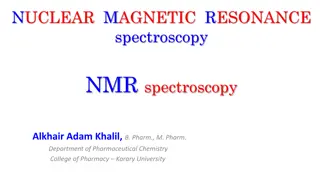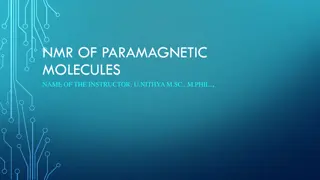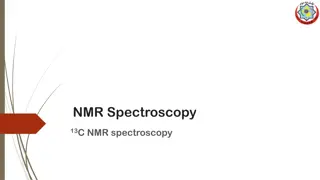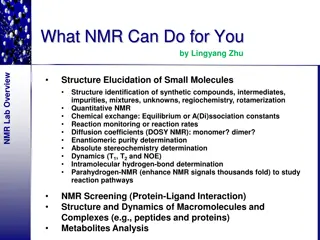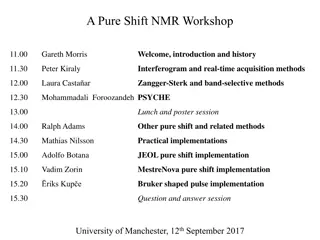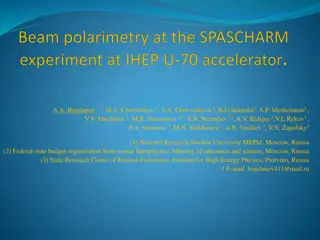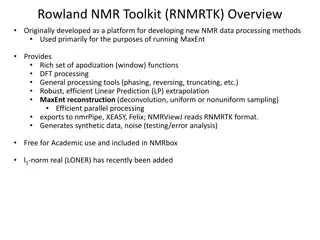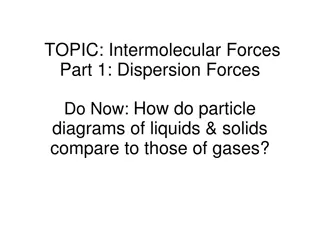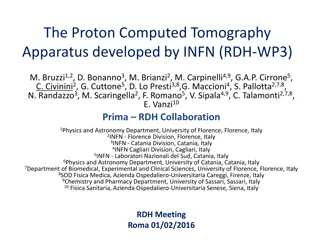1H NMR and Proton Environments in Molecules
Exploring the concept of proton environments in molecules using 1H NMR spectroscopy. The presence of different types of hydrogens in a molecule is highlighted, showcasing how protons exist in varied magnetic environments leading to distinct signals in the 1H NMR spectrum. Electron shielding and its role in generating magnetic fields around atoms are also discussed.
Download Presentation

Please find below an Image/Link to download the presentation.
The content on the website is provided AS IS for your information and personal use only. It may not be sold, licensed, or shared on other websites without obtaining consent from the author.If you encounter any issues during the download, it is possible that the publisher has removed the file from their server.
You are allowed to download the files provided on this website for personal or commercial use, subject to the condition that they are used lawfully. All files are the property of their respective owners.
The content on the website is provided AS IS for your information and personal use only. It may not be sold, licensed, or shared on other websites without obtaining consent from the author.
E N D
Presentation Transcript
Atoms in the Absence and Presence of an Applied Magnetic Field
Magnetically Susceptible Nuclei 1H, 2H, 13C, 14N, 17O, 19F, 31P, 35Cl & others!
Magnetically Susceptible Nuclei 1H, 2H, 13C, 14N, 17O, 19F, 31P, 35Cl & others! Not an exhaustive list of the Periodic Table.
Magnetically Susceptible Nuclei 1H, 2H, 13C, 14N, 17O, 19F, 31P, 35Cl & others! Not an exhaustive list of the Periodic Table. It seems this technique would give a list of the magnetically susceptible elements in the molecule. Question? Are all the Hydrogens in a molecule in exactly the same environment?
Proton Environment Are all the H s the same or in the same environment?
Proton Environment Are all the H s the same or in the same environment? In fact there are four different types of hydrogen in this molecule.
Proton Environment Are all the H s the same or in the same environment? In fact there are three different types of hydrogen in this molecule.
Proton Environment Are all the H s the same or in the same environment? In fact there are four different types of hydrogen in this molecule. Why are they different? Protons exist in different magnetic environments.
Electron Shielding Movement of electrons generates a magnetic field. Greater electron density around an atom shields the atom from the applied magnetic field and that atom exists in a different environment. Protons in different environments give signals in different regions of the 1H NMR spectrum.
What Effects Electron Shielding? Electronegativity of the Substituents Hybridization Number of Substituents.
Information Obtained Number of different hydrogen in the molecule. Position of the resonance suggests the possible molecular environment. New Info!...Area under peaks can provide the relative number of protons (integration). New Info!...splitting of signals into well-defined multiple peaks indicates the number of nonequivalent neighbors.
1,1-diphenyl-2-propanone 100 3 1
Benzylacetate 5 3 2
Coupling (spin-spin splitting) (n + 1) Rule Spin information between neighboring protons is transmitted between carbon directly connected to one another. This leads to splitting of the peaks on neighboring carbons. Number of peaks will be equal to the number of protons on the neighboring carbon plus one (n + 1).
Bromoethane 3 2
Bromoethane 3 2 Provides information about the connectivity of the molecule.
Ethanol 3 2 NOTE: Protons on heteroatoms (N, S, O) do not usually couple with the protons on neighboring carbons!! 1
Ethyl Acetate 3 3 2
Ethyl Butate 3 3 NOTE: Protons can overlap with one another on the spectrum and it can be messy!! 2 2 2
Octanol Sometimes very difficult to get accurate integration data if a large number of signals are overlapping.
Propanamine 2 3 Protons on herteroatoms usually do not couple. 2 2
Things to Remember Integration provides an empirical ratio and may not be the absolute number of protons in the structure. (think about molecules that a high degree of symmetry). Protons in the same environment lead to single signal (symmetry in the molecule). Different proton signals may overlap with one another. Coupling (n + 1)!!!! Protons on heteroatoms tend not to couple with protons on neighboring carbons.




